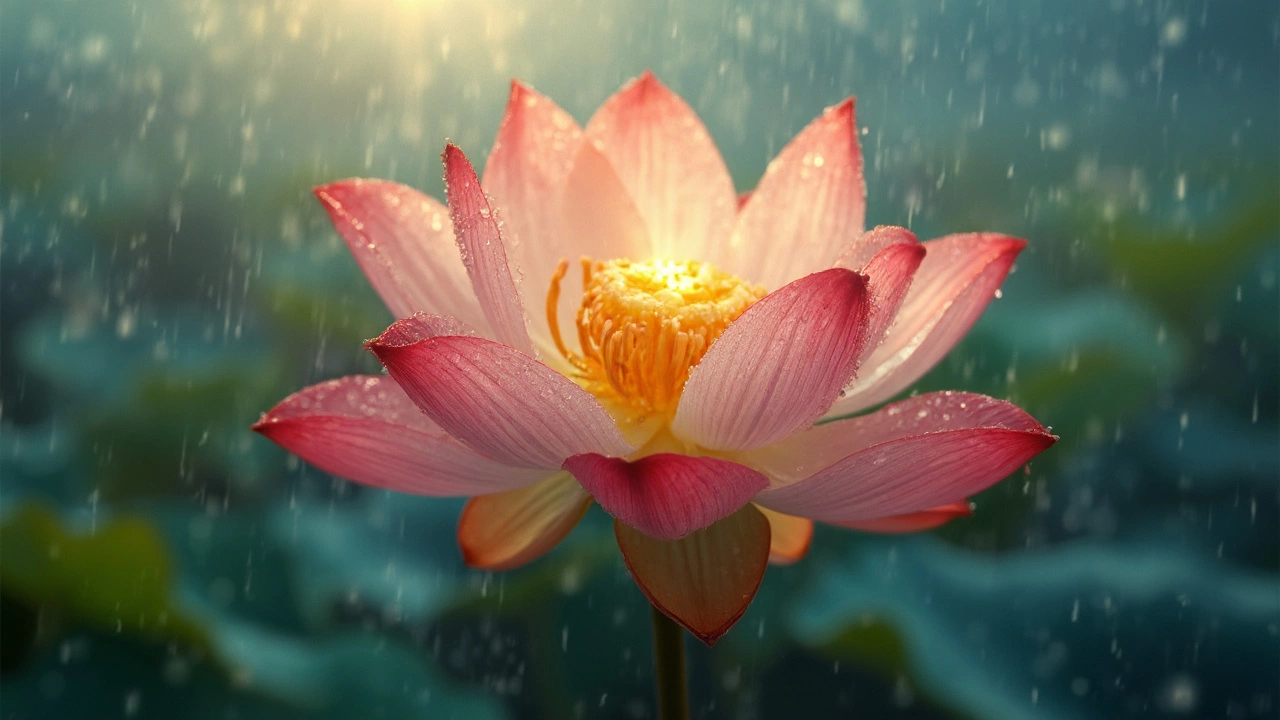The lotus isn’t just another pretty flower—it’s India’s official national flower. If you ask around in India, plenty of people will happily point it out in ponds, temples, even old coins. The lotus stands for purity, resilience, and a kind of beauty that pops up even in the muddiest waters—literally and symbolically.
It’s not hard to find a lotus blooming in the hot, sticky months after the monsoon. They come in whites, pinks, and sometimes blue tints, floating above the water on strong, waxy leaves. But there’s more going on with this plant than just looks. If you’re curious about what makes the lotus matter in Indian seasons and daily life, or maybe you want one in your garden, you’re in the right spot.
- Meet India’s National Flower
- Cultural and Religious Significance
- How the Lotus Handles the Seasons
- Surprising Facts About the Lotus
- Tips for Growing Lotus at Home
- The Lotus in Everyday Indian Life
Meet India’s National Flower
The national flower of India is the lotus, which goes by the scientific name Nelumbo nucifera. It’s a big deal—officially recognized since 1950 when India picked its national symbols. If someone mentions the country’s identity, this flower pops up right alongside the tiger and peacock.
The lotus isn’t shy about where it grows. You’ll see it floating on ponds, lakes, and even slow-moving rivers across the country, mostly in the states of West Bengal, Assam, Uttar Pradesh, and Tamil Nadu. The flower is easy to spot—think big, paddle-like leaves and round, soft petals that stand tall out of the water.
What really makes this plant special isn’t just the looks. The lotus can stay dormant for years and suddenly bloom when the conditions are right. Its seeds are like tiny tanks; one batch found in China actually sprouted after 1,300 years. Talk about staying power.
Here’s a quick breakdown of how the India national flower, the lotus, stands out:
- Scientific Name: Nelumbo nucifera
- Native to: Asia and parts of Australia
- Blooming Season: June to September (right after monsoon)
- Typical Colors: Pink, white, sometimes bluish hues
- Habitat: Freshwater ponds, lakes, and slow rivers
- Edible parts: Roots and seeds are cooked in various Indian dishes
| Feature | Details |
|---|---|
| Official Status | National Flower of India (since 1950) |
| Size | Flowers up to 20cm across; leaves can reach 60cm in diameter |
| Lifespan of Seeds | Over 1,000 years (world record: 1,300 years) |
| Main States Found | West Bengal, Assam, Uttar Pradesh, Tamil Nadu |
People across India use every part of the lotus. The petals are often used in offerings, especially in temples. The roots (called kamal kakdi) show up in spicy curries or sabzis, and lotus seeds are crunchy snacks or additions to Indian sweets. Its round, waterproof leaves? Folks use those as handy natural plates in some states.
Cultural and Religious Significance
The lotus isn’t just India’s national flower—it pops up everywhere in Indian art, stories, and daily rituals. It’s a symbol of pure beauty growing out of muddy water, something that connects with a lot of people. If you look at ancient Indian scriptures or just walk into a temple, you’ll probably spot the lotus right away. It even shows up in the hands of gods and goddesses in old paintings and statues.
In Hinduism, the lotus is linked to powerful deities like Lakshmi (the goddess of wealth) and Brahma (the creator god). They’re often shown sitting or standing on full-bloom lotus flowers. The lotus basically means spiritual awakening here—sort of like rising above tough situations. Buddhists and Jains also use the lotus as a sign of peace, enlightenment, and kindness.
The design isn’t just for show, either. The lotus shape is all over Indian coins, currency notes, and even official government logos. For school kids, drawing a lotus in art class is like a rite of passage. You’ll find the flower in wedding decorations, traditional rangolis during festivals, and handmade crafts sold in street markets.
- In Hindu rituals, lotus flowers are offered during prayers because they’re thought to bring good luck and positive vibes.
- You’ll see the *lotus throne* design in many temples—basically a pedestal made to look like the flower, where deities are placed.
- During big festivals, people use lotus buds to decorate homes and public spaces since they’re considered super auspicious.
So, the India national flower isn’t just pretty to look at. For millions, it stands for resilience, hope, and a fresh start—no matter how messy things get around you.
How the Lotus Handles the Seasons
The lotus is tough when it comes to weather. It's a fresh-water plant that loves India’s warm, humid climate, especially during and after the monsoon. Most lotus flowers start to bloom in late June or July and keep popping up until September. The plant prefers temperatures between 25°C and 35°C—so it’s made for the typical Indian summer. Too much cold? Not a fan. Once winter rolls in, the lotus goes dormant and the leaves dry up, but the tubers survive under water and wait for next year’s heat.
You’ll mostly find the lotus in calm ponds, village lakes, and slow rivers where water isn’t rushing around. It needs sunlight for at least six hours a day, so you won’t see it do much in the cloudier months. The rainy season fills up ponds, making water levels perfect for the plant to send out new leaves and shoots.
- Blooms in summer and monsoon (late June to September)
- Dormant in cold winter months (December to March)
- Needs at least six hours of direct sun daily
- Loves shallow, muddy beds in fresh water
Here’s a quick look at how the lotus grows with the seasons in India:
| Season | Lotus Activity |
|---|---|
| Summer (April-June) | Shoots emerge, roots get strong |
| Monsoon (June-September) | Blooms pop up quickly, best time to spot flowers |
| Autumn (October-November) | Blooms slow down, some leaves dry up |
| Winter (December-March) | Plant dormant, tubers survive under water |
If you ever wondered why so many ponds fill with colored lotus flowers right after the first big rains, now you know—the timing is all about the weather. India’s national flower knows how to work with the seasons, not against them.

Surprising Facts About the Lotus
The lotus isn’t just beautiful to look at—it’s loaded with surprises most people don’t know. Here’s what stands out:
- The lotus can regulate its temperature. Scientists have found that a blooming lotus flower keeps itself warm, just like humans and some birds. They’ve recorded flower temperatures staying between 30–35°C, even if the air around it is colder or hotter.
- Seeds from ancient times still grow. Lotus seeds are famous for staying alive for centuries. In fact, seeds that are over 1,000 years old have been sprouted and grown by botanists in China. This makes the lotus a real symbol of survival and new beginnings.
- It’s officially protected. Since it’s India’s national flower, picking wild lotuses in certain natural areas is actually illegal. Local authorities want to protect these plants from disappearing, especially as water bodies shrink.
- Every part of the lotus is useful. In India, people eat the stem, petals, and seeds. The seeds (sometimes called “makhana”) are super popular as a snack or in sweets, and the roots (also called “kamal kakdi”) show up in curries and pickles.
- The leaves stay clean no matter what. The surface is naturally waterproof, so mud and water slide off easily. This “self-cleaning” trick is called the lotus effect, and scientists are studying it for making things like dirt-proof paint or waterproof clothing.
Check out these quick stats about the lotus:
| Fact | Details |
|---|---|
| Scientific Name | Nelumbo nucifera |
| Peak Blooming Season | June to September |
| Seed Viability | Over 1,000 years |
| Petal Count | Usually 20-30 per flower |
| Main Uses | Food, medicine, decorations |
The next time you spot a lotus in a pond, think about all this hidden talent. It’s way more than just a pretty face in India’s gardens and temples.
Tips for Growing Lotus at Home
Growing a lotus at home sounds tricky, but you don’t actually need a giant pond or a big backyard. You can get started with just a large bucket or tub, some sunshine, and a little patience. The lotus needs warmth and still water—so the hot Indian summer is your friend here.
If you’re a numbers person, check out some quick facts on what a lotus plant likes best:
| Requirement | Best Range |
|---|---|
| Water Temperature | 21-27°C |
| Direct Sunlight | At least 6 hours/day |
| Soil Depth | 15-25 cm |
Here’s a step-by-step guide if you’re keen to try:
- Pick the right pot or tub: Go for a wide, shallow container—about 50–60 cm across is good. Depth should be at least 25 cm so the roots can spread out.
- Use heavy clay soil: Normal garden soil usually floats away! A thick, loamy soil works best. Press it down gently.
- Plant your lotus tuber sideways: Put it just under the surface of the soil, making sure the growth tips stick out.
- Add water slowly: Pour water until it’s 10–15 cm above the soil. Keep topping up if it evaporates in the heat.
- Give it sun: Lotuses are sun-lovers. Give them at least six hours of direct sunlight daily.
- Don’t move things around a lot: Lotuses hate being disturbed. Once you place the pot, leave it there.
If you notice your lotus not blooming, most of the time, it’s just because the pot’s too small or not enough sun is getting in. Also, don’t use tap water loaded with chlorine—if you have no choice, let it sit out a day before using it.
Aaron and I have a tub on our balcony, and as long as we keep the water steady and give them sun, they bloom all summer. Watching those flowers open up is worth every bit of the effort.
The Lotus in Everyday Indian Life
It’s wild how the India national flower pops up in so many places across daily life. You’ll spot lotus motifs on currency, especially the old ₹1 coins, and even on election symbols for political parties. Temples here use lotus flowers in rituals—a clear sign of purity, warmth, and good luck. It doesn’t matter if you’re at a big city temple or a village shrine, there’s a good chance you’ll see a fresh lotus among the offerings.
Walk into any flower market in India, especially in the rainy season, and you’ll find bundles of lotuses sold for prayers and pooja ceremonies. Schools sometimes use the lotus for drawing competitions and as decoration during festivals like Diwali and Independence Day. Art teachers love it—it’s simple, instantly recognizable, and tied up with patriotic pride.
Food might be the last place you expect, but even lotus seeds and roots turn up in Indian kitchens. Some folks, like my mother-in-law, always keep a stash of dried lotus seeds (called makhana) because they're a traditional snack and apparently good for your heart and digestion. Lotus roots, known as kamal kakdi, get tossed into curries or fried into crispy snacks, especially up north.
In the countryside, ponds full of lotuses aren’t just pretty to look at—they cool down the water, support fish, and even help filter out dirty stuff. Locals sometimes harvest the seeds for extra income, so it’s not just a beauty thing—the lotus puts in practical work too.
Even in modern homes, the lotus is popping up as a pattern for cushion covers, floor mats, and wall stickers. People feel that having the lotus around brings good vibes and a touch of Indian tradition, whether it’s on a tablecloth or in a backyard pond.



